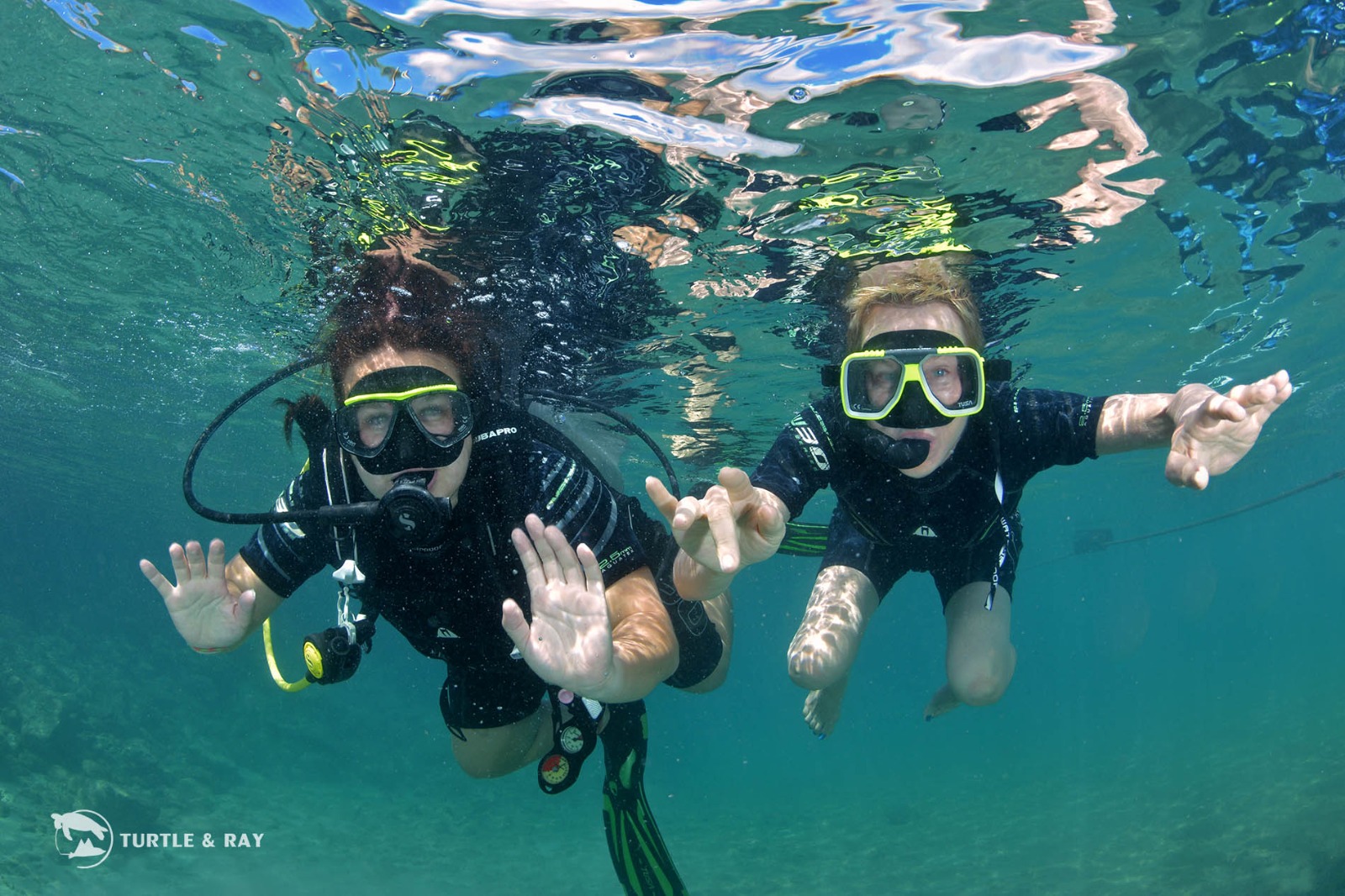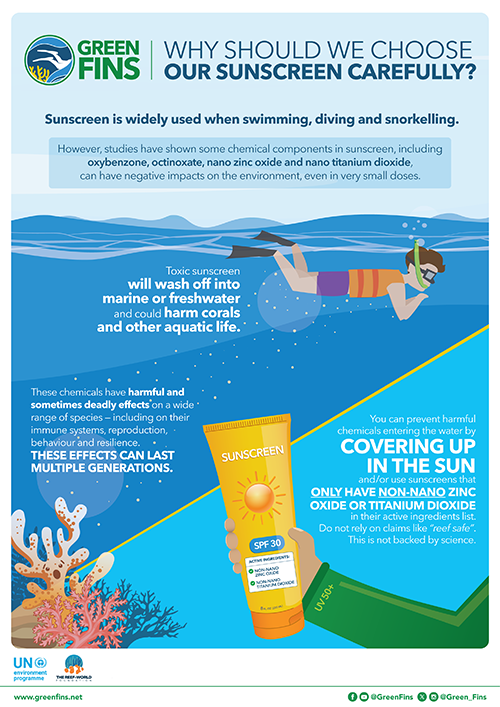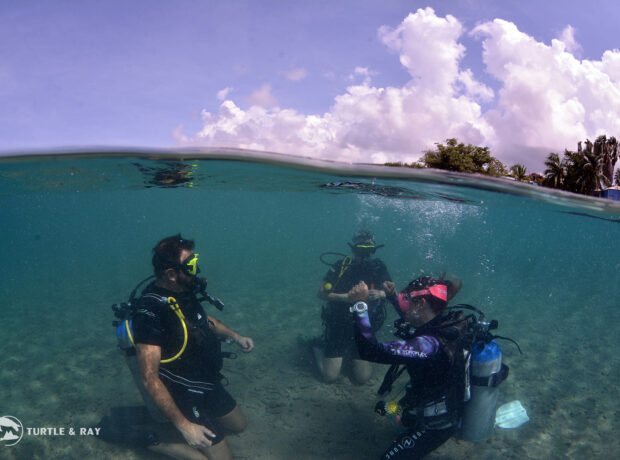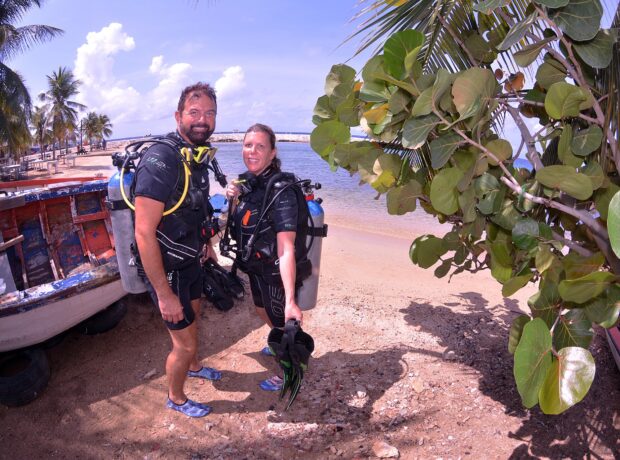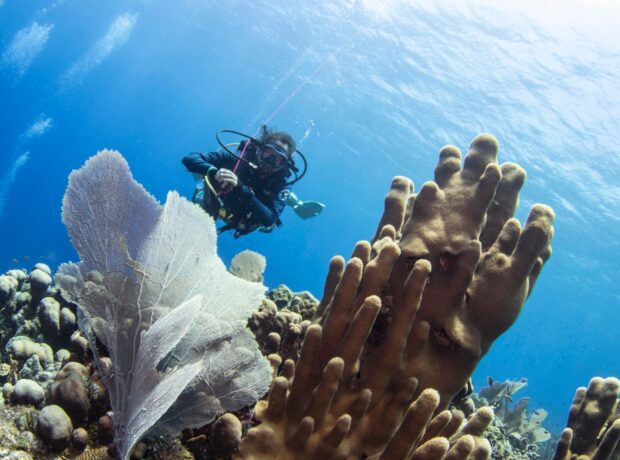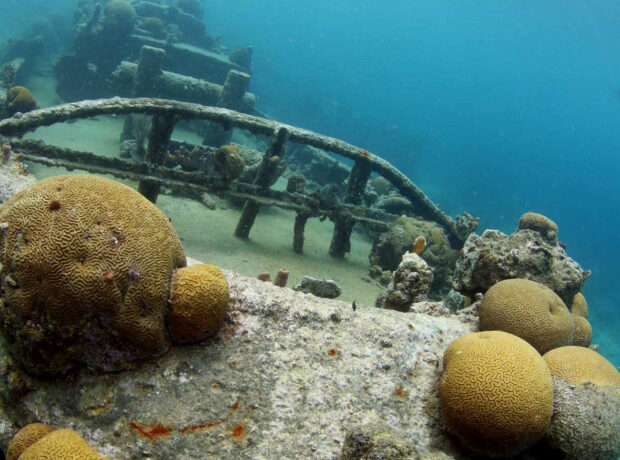Article base on the Green Fins report.
Picture this: you’ve just emerged from an invigorating early morning dive, greeted by the warmth of the sun on your face and the shimmering waters around you. Awaiting you on the boat is a steaming cup of coffee, and with the holiday tan calling, you decide to apply some reef-safe sunscreen. After all, who wants to deal with the discomfort of neoprene on sunburn? You’re not alone — so many of us, including the Reef-World team, prioritise packing reef-safe sunscreen before venturing into the water.
Just one issue: there is no such thing as “reef safe”
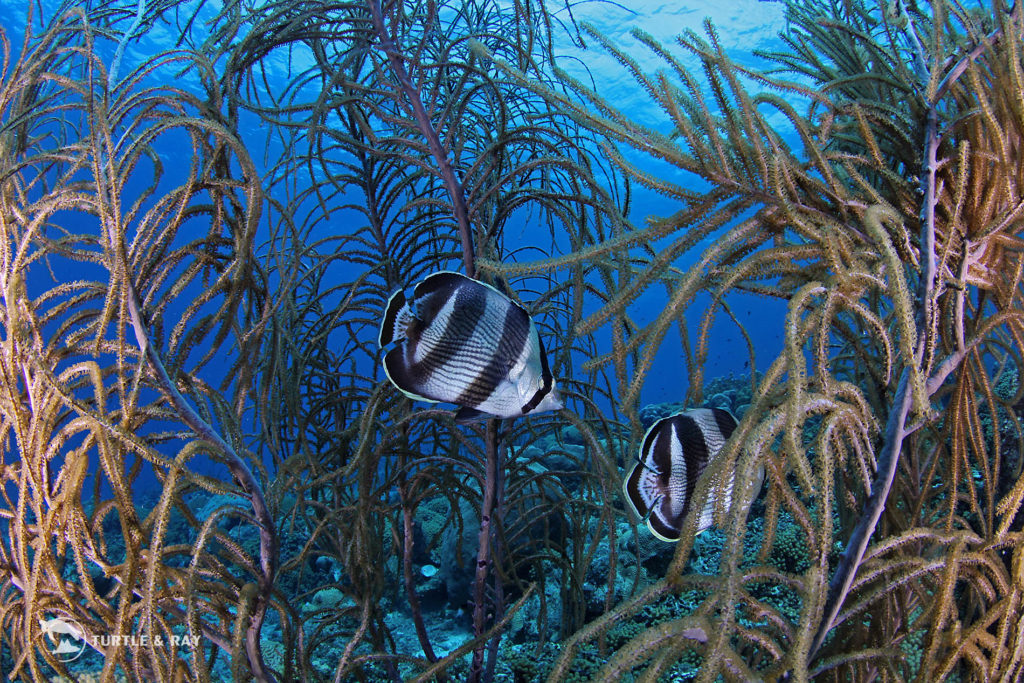
There are two main types of sunscreen:
1. ORGANIC UV FILTERS
In the context of sunscreen chemistry, the term ‘organic’ in chemistry refers to compounds containing carbon. It does not mean biodegradable or non-toxic. Many of these UV filters are petrochemical-based. They work by absorbing UV light. Oxybenzone and octinoxate are examples of organic compounds.
2. INORGANIC UV FILTERS
This refers to mineral UV filters like zinc oxide or titanium dioxide that work by reflecting, scattering or absorbing UV light. There are different sizes of these compounds, which in turn interact with the environment differently. Smaller compounds are more readily absorbed by marine life.
SUNSCREEN BANS TO PROTECT REEFS
In 2018, Palau’s announcement of an upcoming ban on sunscreens containing harmful UV filters sparked a global conversation about the impact of these chemicals on reefs. The International Coral Reef Initiative (ICRI) reinforced this stance the following year, urging the development of environmentally friendly sunscreen without notorious culprits like oxybenzone and octinoxate as well as the development of regulations and policies around its production and sale. As more countries and states announced their own bans, the market responded (before the regulatory bodies), and a surge of “reef-safe” products and new UV filters flooded the market.
But as time flowed on, the term “reef safe” multiplied into confusing variations: reef-friendly, ocean-friendly, coral-safe, marine-friendly, sustainable sunscreen and biodegradable, to name a few. Unfortunately, there is no unified definition of what “reef safe” actually means. There are no regulatory bodies (e.g. FDA, REACH) that test for this label. There are no globally accepted scientific definitions of the term.
“REEF SAFE” AND ALL ITS PERMUTATIONS ARE ONLY MARKETING TERMS.
One of the biggest reasons for this is there are few, if any, standardised toxicological methodologies for marine life, let alone coral.
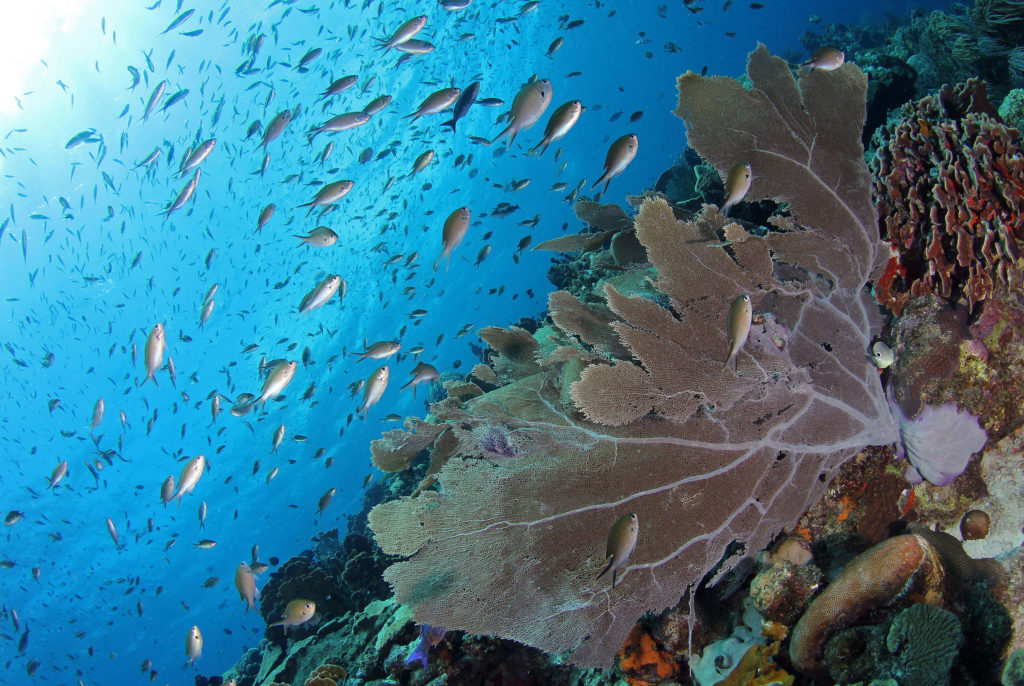
SO, IS SUNSCREEN A MAJOR THREAT TO CORAL REEFS?
Climate change is THE overarching threat to reefs, and conservation efforts have diverged into two prongs: global initiatives dealing with emissions, sequestration and policy, and localised strategies to combat immediate environmental hazards. This enables ecosystems to be more resilient to weather changes in climate and remain functional.
Whilst we don’t know the full story of sunscreen toxicity, the potential impacts are just one of the many local threats that need to be tackled in order to enable reef resilience in a changing climate.
It is vitally important that steps to tackle sunscreen pollution – be it a national ban, a tourism operator policy or an individual consumer choice – are recognised as one tool in the toolbox of environmental protection. It may be a quick win, but avoiding sunscreen alone will not save reefs from bleaching.
DO UV FILTERS AFFECT OTHER ENVIRONMENTS TOO?
Yes, absolutely. UV filter compounds have been shown to affect freshwater species as well as invertebrates that live in temperate waters24 as well as tropical. Tourists diving into freshwater and coldwater environments need to be equally wary of their sunscreen use.
THE NEW GREEN FINS SUNSCREEN POSTERS
In response to the recent science, we have updated the messaging of the Green Fins sunscreen posters with the core message to only buy sunscreens that only use NON-NANO zinc or titanium dioxide as UV filters.
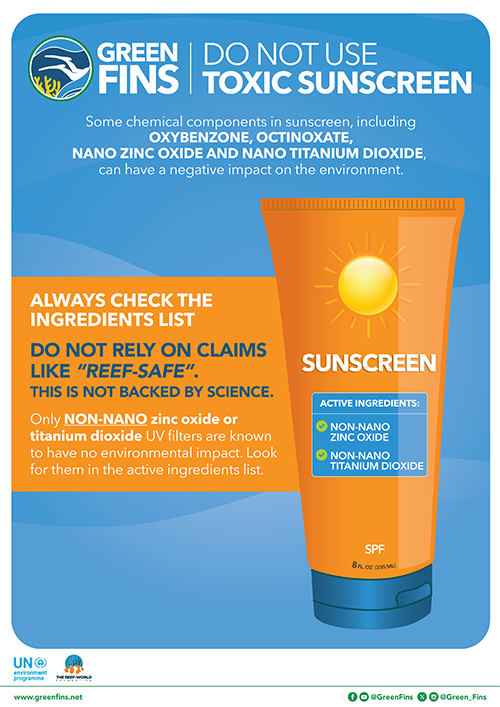
WHAT CAN YOU DO?
Due to the nature of standardised toxicological testing, it is unlikely that any regulatory frameworks will be developed to define ‘reef safe’ and guide the cosmetic industry in the immediate future. So it’s up to us to do our due diligence. Here are some steps you can take today:
1. MINIMISE YOUR NEED FOR SUNSCREEN AROUND THE OCEAN
- Consider covering up with UPF or light clothes instead of sunscreen if you can.
- Stay in the shade during peak sun hours (10am – 3pm)
- Avoid spray or misting sunscreen products
2. CHOOSE SUNSCREENS THAT ONLY HAVE NON-NANO ZINC OXIDE OR NON-NANO TITANIUM DIOXIDE UV FILTERS
It’s imperative to check the ingredients list of your sunscreens and NOT BUY any that contain:
- Oxybenzone
- Octinoxate
- 4-methylbenzylidene camphor
- Octocrylene
- Para-aminobenzoic acid (PABA)
- Methyl Paraben
- Ethyl Paraben
- Propylparaben
- Butyl Paraben
- Benzyl Paraben
- Triclosan
- Homosalate
- Octisalate
- Butyloctyl salicylic acid
- Propylparaben
- Any form of microplastic sphere or beads.
- Any nanoparticles like zinc oxide or titanium dioxide.
Note that applying toxic sunscreen for any amount of time in advance of entering the water makes no difference to its impact on the environment.
3. REDUCE EMISSIONS WHERE YOU CAN
Using non-nano mineral sunscreen is a great tangible choice you can make, but it won’t balance your net impact on the oceans if you’ve flown across the world to use it!
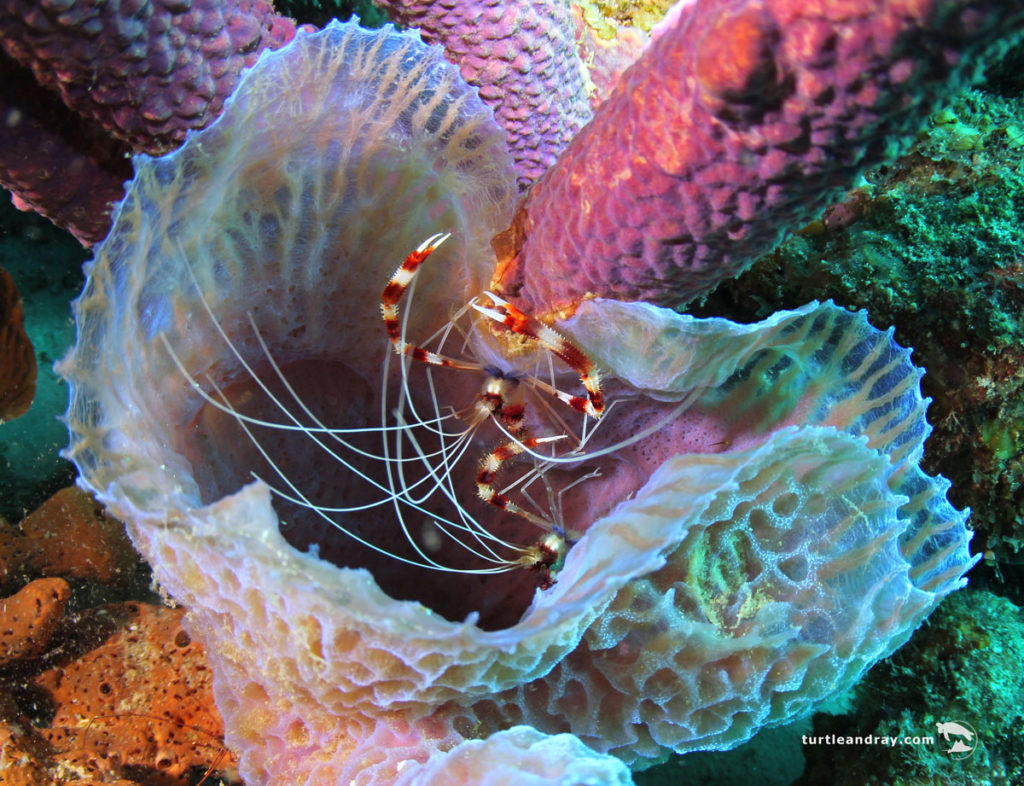
CONCLUSION
Diving into the technical details of sunscreen toxicology in the ocean is complicated and can be overwhelming. The realisation that global and national regulatory toxicology frameworks are falling short in safeguarding the marine environment is disheartening. However, in the face of the imminent 2023-2024 global coral bleaching event, projected to be unprecedented, every step you take to mitigate local threats to the ocean becomes profoundly significant. Each of us plays a pivotal role in fostering resilience and preserving the delicate balance of our underwater ecosystems.
